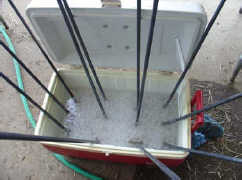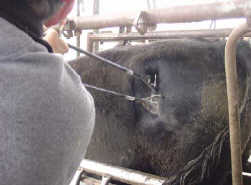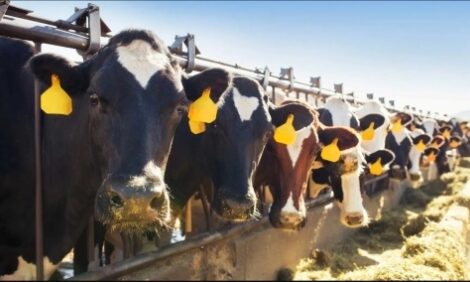



Freeze Branding Basics
By Jane Parish – Extension Beef Cattle Specialist, Mississippi State University.Animal Identification
With the National Animal Identification System in the spotlight, there is significant emphasis on individual identification of beef cattle. Individual animal identification is an integral part of good herd record keeping and management. Selection decisions, pairing up cows and calves, treating injured or ill cattle, and estrus detection are just a few of the many routine management practices where individual animal identification is important. The 1997 National Animal Health Monitoring System BEEF ’97 study found that approximately half (51.9%) of the beef cattle operations surveyed across the U.S. used no individual calf identification. Operations with over 50 head were more likely to use some form of individual calf identification (78.1% of the larger herds compared to only 40.8% of smaller operations with less than 50 head used individual calf identification). Plastic ear tags were cited as the most common form of individual animal identification regardless of herd size. In the Southeast, 30.2% of beef cows were individually identified using plastic ear tags, 16.0% with hot iron brands, 11.6% with ear notches, 5.9% with ear tattoos, 2.3% with metal ear tags, and only 1.2% with freeze brands.
One of the oldest forms of individual animal identification is branding. Brands are a form of permanent identification of livestock that serve as a theft deterrent. Brands can serve as both a method of herd identification (where each animal has the same herd identifier) as well as a method of individual animal identification (where each animal has a unique identifier). In the NAHMS BEEF ’97 survey, plastic ear tags and hot iron branding were found to be the most common forms of herd identification in the U.S. At the Leveck Animal Research Center (South Farm) on the MSU campus, both herd and individual identifiers are branded onto all beef herd replacements and bulls. All cattle at the South Farm are tattooed in both ears, tagged with a plastic ear tag, and tagged with an electronic ear tag at birth with unique identifiers. Branding on the South Farm routinely takes place at yearling age. Three-inch branding irons are used. Charolais cattle are branded with hot iron brands, while Angus and Hereford cattle are branded with freeze brands. The commercial herds are branded similarly dependent upon hair coat color.
Freeze Branding Methods
Freeze branding can be a relatively painless and very effective form of permanent animal and herd identification. Research results out of Texas and Canada have shown that freeze branding results in less discomfort to cattle than hot iron branding. While hot iron branding is used to make a neat, legible scar on the surface of the hide, the goal with freeze branding is to convert hair pigmentation to white in a legible manner. Freeze branding destroys the natural pigments in hair, producing white hair growth. Freeze brands typically become legible about six to eight weeks after branding. Right as a new hair coat is starting (fall or spring) is a good time to freeze brand. Freeze branding can be successful during any time of the year, but brands applied after a new hair coat is already on an animal may take up to four months to appear as white hair.
There are basically two effective methods for cooling freeze branding irons. Liquid nitrogen can be used or a combination of denatured alcohol and dry ice can be used. Both methods have been used at the South Farm, but the current method of choice is the alcohol and dry ice method because of the reduced risk of scarring. The downside to the alcohol and dry ice method is that the iron must be placed on the hide for a longer period of time than with the liquid nitrogen method. Liquid nitrogen (-344o F) cools freeze branding irons to a colder temperature than alcohol and dry ice (-112o F). When liquid nitrogen is used to cool branding irons, the irons should be pressed against the hide for approximately 20 to 45 seconds depending upon the age of the animal and outside temperature. Hot summer temperatures and thicker hides in cattle of Brahman breeding may necessitate longer branding durations. When denatured alcohol and dry ice are used to cool branding irons, the irons should be pressed against the hide for approximately 45 to 50 seconds. White cattle can be freeze branded to achieve a bald or bare brand by holding the branding irons in place against the hide for a total of approximately 60 seconds. The extra time needed for freeze branding may reduce the number of head that can be branded over a given period of time, but the end results can be very worthwhile.
Supplies needed for freeze branding with dry ice and alcohol include: a cattle working facility with an area to restrain individual animals (squeeze chute), freeze branding irons, a plastic or Styrofoam (not metal) ice chest, dry ice, denatured alcohol, clippers and a source of electricity to run them, a spray bottle, a rag or brush to clean the clipped area, and a timer or clock with a second hand.
Irons suitable for freeze branding are often made of copper alloy. Brass, stainless steel, and aluminum irons may also be used, but the copper irons tend to be most effective. They may look a little different than hot branding irons in that, with freeze branding irons, there is not a need for breaks in the metal brand at key joints to release excess heat. Some of the stainless steel irons are designed to be used for both freeze and hot iron branding and will have breaks. There are many different sizes of irons available. Decide on what size is needed to be legible at a distance and is appropriate for the particular brand location and age of animal. At the South Farm, yearlings are branded immediately below the hip with three-inch irons. Four-inch irons were used in the past, but the recent move to smaller irons was an attempt to improve the appearance of the brands and reduce the extent of hide damage. Some other Mississippi beef cattle operations brand on the shoulder with irons as small as 1 ½ inches in height, for example.
With the alcohol and dry ice method of freeze branding, use a mixture that allows the irons to be submerged but is not watery. A 50:50 mixture often works well. Approximately one gallon of alcohol and 20 pounds of dry ice will brand about 20 head of cattle in most situations. If planning to work a full day, then 50 to 75 pounds of dry ice will be needed. Using denatured isopropyl, methyl, or ethyl alcohol with a high purity level is critical to prevent freezing and slush buildup. A minimum of 95% purity is needed. Ninety-nine percent pure denatured alcohol works best. When the humidity is high, the solution will become diluted with moisture taken up by the alcohol from the atmosphere over time. Draining the used alcohol and replacing it with fresh alcohol after several hours of use may be advisable on humid days.
Place irons in an ice chest with enough dry ice and alcohol to completely submerge the branding surface of the irons and at least part way up the handle above the branding surface. About two inches of crushed dry ice covering the bottom of the cooler is needed. The alcohol/ dry ice mixture will slowly evaporate, so additional alcohol and dry  ice will need to be added throughout the cattle working session to keep the iron surfaces submerged. Irons are ready to use when the refrigerant mixture stops boiling and frost builds up around the base of the irons. Waiting fifteen to twenty minutes from the time that the irons are first placed in the cooler until first use is a good rule of thumb. The more irons to be cooled, the longer this generally takes. When irons are reused, make sure that they are cooled for at least one to two minutes between applications.
ice will need to be added throughout the cattle working session to keep the iron surfaces submerged. Irons are ready to use when the refrigerant mixture stops boiling and frost builds up around the base of the irons. Waiting fifteen to twenty minutes from the time that the irons are first placed in the cooler until first use is a good rule of thumb. The more irons to be cooled, the longer this generally takes. When irons are reused, make sure that they are cooled for at least one to two minutes between applications.
 Before applying branding irons to the hide surface, make sure that the animal is properly restrained (preferably in a squeeze chute) and that the branding area is clipped, cleaned, and sprayed with a layer of denatured alcohol. Clipping serves two purposes. It prepares the hide to receive the brand by removing the layers of hair that serve as insulation, and it provides a visual guide for brand placement. The shorter the hair is clipped, the shorter the duration of branding iron application needed to create a good brand. Clipping in a block pattern with level and square edges makes brand proper placement much easier and can result in a more attractive brand. A cloth rag or brush should be used to remove clipped hair, manure, and other debris that may interfere with iron to hide contact. The layer of denatured alcohol sprayed onto the hide helps transfer the cold temperature of the iron to the hide. A very generous amount of denatured alcohol should be applied to saturate the hide.
Before applying branding irons to the hide surface, make sure that the animal is properly restrained (preferably in a squeeze chute) and that the branding area is clipped, cleaned, and sprayed with a layer of denatured alcohol. Clipping serves two purposes. It prepares the hide to receive the brand by removing the layers of hair that serve as insulation, and it provides a visual guide for brand placement. The shorter the hair is clipped, the shorter the duration of branding iron application needed to create a good brand. Clipping in a block pattern with level and square edges makes brand proper placement much easier and can result in a more attractive brand. A cloth rag or brush should be used to remove clipped hair, manure, and other debris that may interfere with iron to hide contact. The layer of denatured alcohol sprayed onto the hide helps transfer the cold temperature of the iron to the hide. A very generous amount of denatured alcohol should be applied to saturate the hide.
Always check your iron and animal information before branding to make sure the correct iron is about to be applied. Begin timing the branding process on an animal when the iron first contacts the hide. Use significant pressure to make sure that there is good contact for the entire surface of the iron. The animal may jump within the first 10 seconds of brand contact. The extreme cold usually freezes the nerve endings after 10 seconds, and the animal will stop moving in most cases. As an animal moves around, maintain contact in the same location. Put a good bit of force behind the iron by leaning into the iron to get good contact and prevent it from sliding around. If the iron loses contact with the branding location on the hide, then reapply the iron to the same location. An outline of the brand number, letter, or symbol should be readily visible to show where to reapply the iron. Keep up with the amount of time the iron contacts the hide to get the full 45 to 50 second application needed for a good brand.
Quality Challenges
Beef Quality Assurance should be considered when branding cattle. Hides are an important by-product of beef production, and too much hide damage due to brands was cited as one of the top ten quality challenges facing the beef industry in the 2000 National Beef Quality Audit (NBQA). The 2000 NBQA revealed that 49.3% of the fed cattle assessed were not branded. Brand size and location impact the ultimate value of the hide. Of the cattle evaluated as part of the 2000 NBQA, 4.4% had multiple brands, 3.6% had shoulder brands, 13.7% had side brands, and 36.3% had butt brands. Side brand sizes ranged from 1 to 900 square inches (yes, that number is 900 and not a typo). One of the industry goals set forth in the 2000 NBQA was to completely eliminate side branded hides. Cattle should be in good flesh when branding. Thin cattle can be more difficult to brand effectively, and the end result may not be satisfactory. Both excessive hide damage and poor placement of brands can be avoided by practicing responsible branding. Freeze branding can be a good alternative to hot iron branding in many situations for reducing hide damage.
There is great potential for increased use of freeze branding in Mississippi. It is actually a relatively simple procedure that just takes a little preparation and patience during the process. Contact your local county Extension office for more information on cattle identification or related topics.
May 2006


